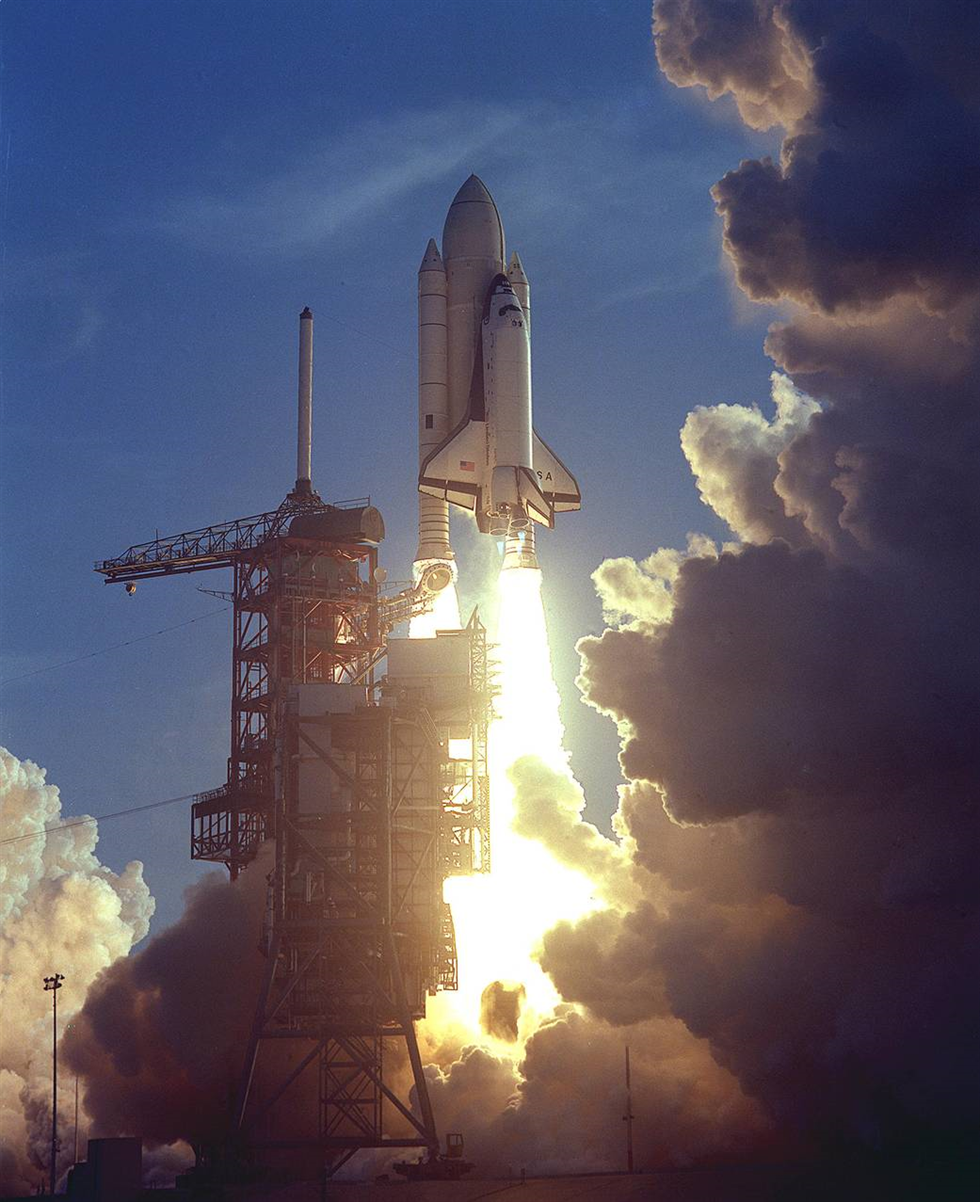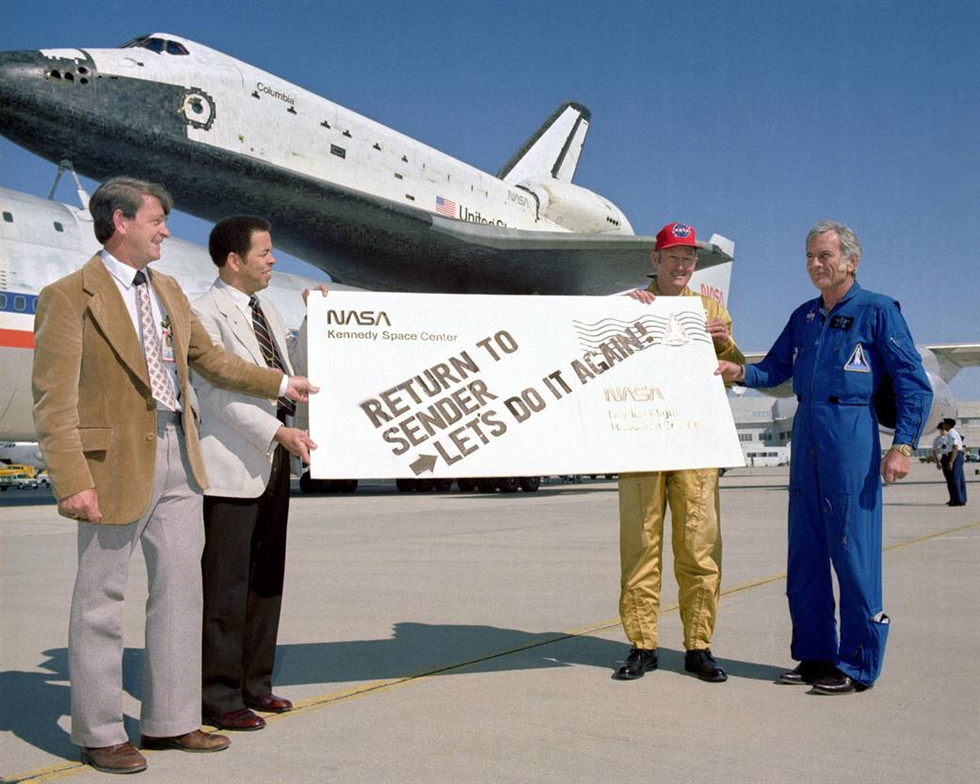That 'Lessons and Legacies' cheat sheet you were hoping for
2016-09-08
The spirit of human spaceflight is alive and well at Johnson Space Center and, as we look forward with Orion, we must also remember the history that brought us this far. Our space shuttle was home to Spacelab, visited Mir, launched and served the Hubble Space Telescope and was critical to the construction of the International Space Station. Because of shuttle, astronauts conducted thousands of vital experiments, and the spinoffs and transferable technologies developed during the course of the program radically advanced lifesaving and life-enhancing innovations for humanity. The impact of those technologies and shuttle’s discoveries will be felt forever.
As 2016 is the 35th anniversary of the first two shuttle launches, JSC will be hosting a panel discussion on Sept. 16 at 10:30 a.m. in the Teague Auditorium featuring a couple of shuttle’s first astronauts and program experts. Lessons and Legacies is an open-invitation occasion for the entire JSC family, and you can learn more about it here.
Since JSC gets a little younger each year as more and more millennials join our ranks, below is a quick cheat sheet to bring you up to “warp-speed” in time for the panel. Not alive in 1981? No problem!
Because of shuttle’s unique landing process, it required plenty of testing.
In preparation for STS-1 and STS-2, Enterprise was flown to conduct four Approach and Landing Tests to verify controllability after being released by a Boeing 747.
STS stands for Space Transportation System, the official name for the shuttle program.
The massive payload capacity of the shuttle made it possible to transport and return more materials to and from space than had ever been feasible before … and since.
Shuttle was the first reusable space vehicle in human history.
The crew of STS-1 and STS-2 both flew aboard Columbia. Columbia logged a combined 2.149 million miles and 108 hours, 34 minutes and 5 seconds in her first two flights. The shuttle’s reusability revolutionized the way we venture into space, ensured long-term program flexibility and radically expanded what we could accomplish in space.
For STS-1 and STS-2, the external fuel tanks were white.
By STS-3, this look changed to the iconic orange we all (even millennials!) remember. This change wasn’t an aesthetic decision, however. It reduced the weight of the craft.
STS-1 was flown by a crew of two: Commander John Young and Pilot Robert Crippen.
Later missions would fly with up to seven astronauts, but the first two missions flew with only two. Young was a Gemini and Apollo veteran and had logged many hours walking on the moon. Crippen would go on to fly in three more shuttle missions, logging more than 565 hours in space.
STS-2 was the only “all rookie” crew in the entire Space Shuttle Program.
It included Commander Joe Engle and Pilot Richard Truly, neither of whom had previously been to space. Every subsequent shuttle flight included at least one crew member that had previously flown in space.
STS-2 was the first use of the shuttle’s robotic arm.
Officially known as the Shuttle Remote Manipulator System (SRMS) and also called Canadarm, the SMRS was built by Canada and allowed the crew of the shuttle to work with satellites, building blocks of the International Space Station and other payloads. The robotic arm played a very important role in assembling the space station.
STS-1 and STS-2 marked the beginning of a 135-mission program that spanned 30 years.
During that time, the shuttle became a national icon and a symbol of American success and progress. Many thousands of NASA and JSC careers centered on shuttle’s great discoveries, and the collective expertise derived from the program allows us to prepare for current and future missions.
Don’t forget to attend Lessons and Legacies at 10:30 a.m. on Sept. 16 in the Teague Auditorium. If you have questions for our panelists, submit them online and check out what others have asked as well. Our new question voting tool allows users to “upvote” questions to make sure their favorite is asked first.
Happy 35th anniversary, space shuttle!
Morgan McAllister
NASA Johnson Space Center
As 2016 is the 35th anniversary of the first two shuttle launches, JSC will be hosting a panel discussion on Sept. 16 at 10:30 a.m. in the Teague Auditorium featuring a couple of shuttle’s first astronauts and program experts. Lessons and Legacies is an open-invitation occasion for the entire JSC family, and you can learn more about it here.
Since JSC gets a little younger each year as more and more millennials join our ranks, below is a quick cheat sheet to bring you up to “warp-speed” in time for the panel. Not alive in 1981? No problem!
Because of shuttle’s unique landing process, it required plenty of testing.
In preparation for STS-1 and STS-2, Enterprise was flown to conduct four Approach and Landing Tests to verify controllability after being released by a Boeing 747.
STS stands for Space Transportation System, the official name for the shuttle program.
The massive payload capacity of the shuttle made it possible to transport and return more materials to and from space than had ever been feasible before … and since.
Shuttle was the first reusable space vehicle in human history.
The crew of STS-1 and STS-2 both flew aboard Columbia. Columbia logged a combined 2.149 million miles and 108 hours, 34 minutes and 5 seconds in her first two flights. The shuttle’s reusability revolutionized the way we venture into space, ensured long-term program flexibility and radically expanded what we could accomplish in space.
For STS-1 and STS-2, the external fuel tanks were white.
By STS-3, this look changed to the iconic orange we all (even millennials!) remember. This change wasn’t an aesthetic decision, however. It reduced the weight of the craft.
STS-1 was flown by a crew of two: Commander John Young and Pilot Robert Crippen.
Later missions would fly with up to seven astronauts, but the first two missions flew with only two. Young was a Gemini and Apollo veteran and had logged many hours walking on the moon. Crippen would go on to fly in three more shuttle missions, logging more than 565 hours in space.
STS-2 was the only “all rookie” crew in the entire Space Shuttle Program.
It included Commander Joe Engle and Pilot Richard Truly, neither of whom had previously been to space. Every subsequent shuttle flight included at least one crew member that had previously flown in space.
STS-2 was the first use of the shuttle’s robotic arm.
Officially known as the Shuttle Remote Manipulator System (SRMS) and also called Canadarm, the SMRS was built by Canada and allowed the crew of the shuttle to work with satellites, building blocks of the International Space Station and other payloads. The robotic arm played a very important role in assembling the space station.
STS-1 and STS-2 marked the beginning of a 135-mission program that spanned 30 years.
During that time, the shuttle became a national icon and a symbol of American success and progress. Many thousands of NASA and JSC careers centered on shuttle’s great discoveries, and the collective expertise derived from the program allows us to prepare for current and future missions.
Don’t forget to attend Lessons and Legacies at 10:30 a.m. on Sept. 16 in the Teague Auditorium. If you have questions for our panelists, submit them online and check out what others have asked as well. Our new question voting tool allows users to “upvote” questions to make sure their favorite is asked first.
Happy 35th anniversary, space shuttle!
Morgan McAllister
NASA Johnson Space Center

A new era in spaceflight begins on April 12, 1981, when the first shuttle mission soars into orbit from NASA's Kennedy Space Center in Florida. Image Credit: NASA

After completing its first orbital mission with a landing at Edwards Air Force Base on April 14, 1981, Space Shuttle Columbia received a humorous sendoff before its ferry flight atop a modified 747. From left to right: Melvin Burke, DFRC Orbital Flight Test (OFT) program manager; Isaac “Ike” Gillam, DFRC center director; Fitzhugh “Fitz” L. Fulton Jr., NASA DFRC 747 SCA pilot; and Donald K. “Deke” Slayton, JSC OFT project manager. Image Credit: NASA







